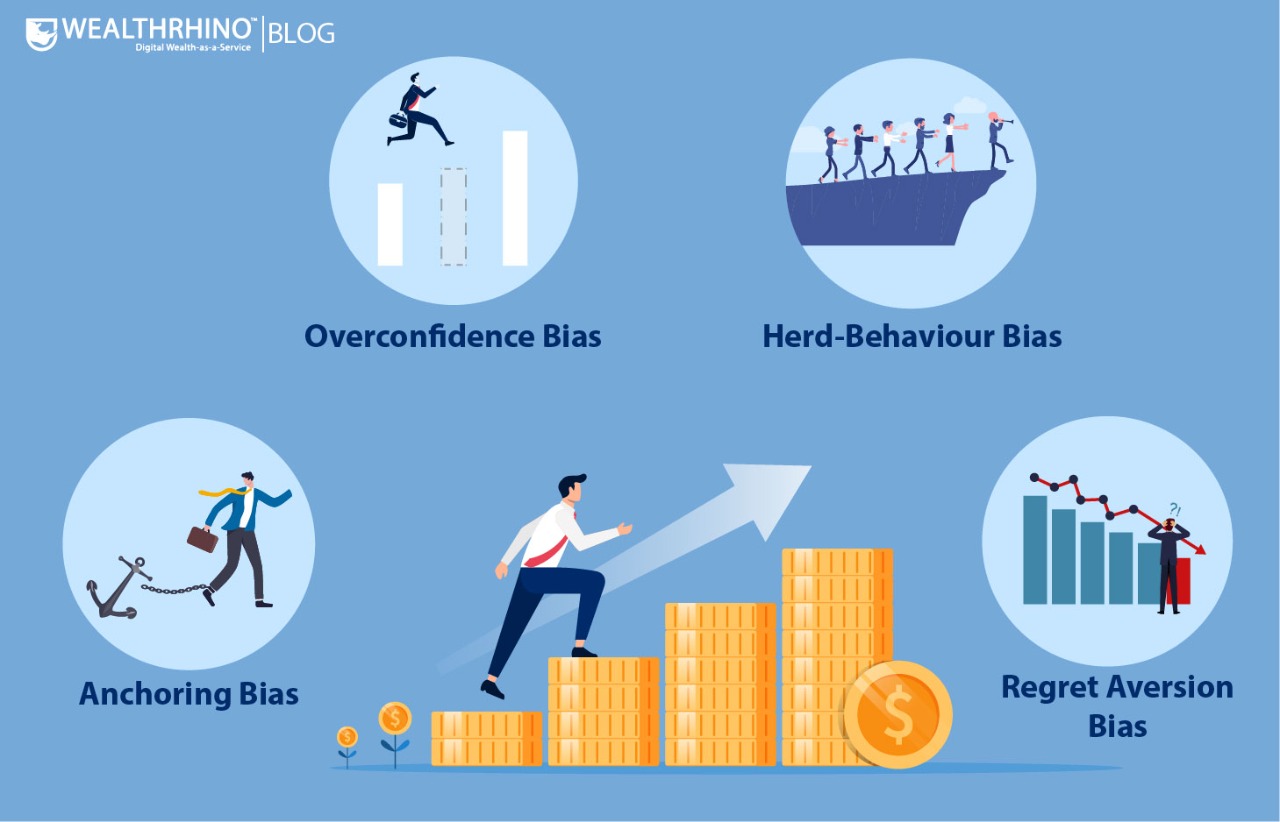TABLE OF CONTENT
1. Behavioral Biases- A Basic Understanding
2. What is Behavioral Biases & its Importance
3. 4 Common Behavioral Biases
3.1. Overconfidence Biases
3.1.1. How to Overcome Overconfidence Bias?
3.2. Regret Aversion Biases
3.2.1. How to Overcome Regret Aversion Bias?
3.3. Anchoring Biases
3.3.1. How to Avoid Anchoring Bias?
3.4. Herd-Behavioral Biases
3.4.1. How to Overcome Herd-Behavior Bias?
4. Takeaway
Behavioral Biases- A Basic Understanding
Suppose you receive an INR 10,000 bonus from your employer. A race of thoughts starts in your minds to spend on expensive meals, clothing, or luxury commodities. Or, you have an option to invest it in a mutual fund.
Many individuals would like to spend that extra fortune and welcome happiness, while few will think to invest it in attaining future benefits. Psychologically, the answer lies with behavioral finance that examines how our brain affects our money management skills.
Likewise, in trading, behavioral bias plays a crucial role in influencing investors' decisions in the financial market.

What is Behavioral Biases & its Importance
Behavioral finance studies psychological factors that influence an investor's decision to -buy, sell, or hold- trades and securities in the finance market.
Behavioral finance focuses on the fact that investors cannot always be rational. It states that regardless of how organized and disciplined investors or traders are, they often make financial decisions based on their emotions and have their own limits. Hence, they act on their feelings or make mistakes while trading.
Behavior finance predicts actual trading behavior on emotional factors of the investors and uses them to create efficient trading strategies that are needed while trading.
4 Common Behavioral Biases
Here, we highlighted four prominent behavioral biases that a retail trader or investor faces while making trading decisions. Also, we will provide you with some guidance to overcome these biases and use them in the right direction.

Overconfidence Biases
Overconfidence is a weapon of self-destruction, especially in trading. In the trading encyclopedia, overconfidence bias is the tendency of an investor or a trader to overestimate their abilities. According to the sources, nearly 75% of investors consider themselves better-than-average investors.
Overconfidence bias tricks our brain into believing that it's possible to beat the market by making risky and inconsistent bets. However, it can lead an average investor to the path of poor investment choices and decline their performance.
How to Overcome Overconfidence Bias?
Trade Less, and Investment More!
Resist the urge to think of yourself better than anyone else. Instead, increase your time frame in monitoring trades that can help you earn consistently. Then, focus on attaining long-term goals and build your trading strategy accordingly.
.jpeg?width=1280&name=WhatsApp%20Image%202021-12-27%20at%201.47.44%20PM%20(1).jpeg)
Regret Aversion Biases
Many a time, an investor or a trader refuses to decide out of fear. Then, later, when the trade is performing well in the stock market, they regret their decision emotionally. When they cannot move ahead from their regret, this feeling is known as regret aversion bias.
Eventually, an investor suffering from regret aversion bias will avoid investing in risky trades. If the trade performs according to their interpretation, they feel confident. But, on the other hand, if it outperforms their expectations, they develop a feeling of missing out (FOMO).
How to Overcome Regret Aversion Bias?
First, Never Make Trades on Emotions!
We would recommend the investors first set a trading strategy for themselves and never change it. Then, diversify your portfolio into different equity and debt instruments according to your risk-taking decisions.
For instance, if you hold INR 100,000 for trading, only invest 3% of your trading, i.e., INR 3000 in risky equity and rest in debt instruments.
.jpeg?width=1280&name=WhatsApp%20Image%202021-12-27%20at%201.47.45%20PM%20(1).jpeg)
Anchoring Biases
Many investors or traders heavily study the charting patterns and gather valuable insights about the market trends. But, sometimes, they focus too much on a single piece of information that might be irrelevant or irrational to make trading decisions.
Anchoring bias is a type of behavioral finance where an investor relies too much on information to make subsequent judgements. Before making investment decisions, it is essential to undertake fundamental and technical analyses of trading commodities. Depending on market tips or a single piece of information might be vulnerable for investors.
How to Avoid Anchoring Bias?
Believe Yourself!
We recommend you first study the market trends, gain insights, and make investing decisions. Then, follow your preferred trader or learn the stock market technicalities from the experts to perform trading. Finally, ignore the tips and rumor that go viral unnecessarily.

Herd-Behavioral Biases
Herd behavior implies following the sheep. So when an investor blindly follows the same steps- from making trading strategies to buying and selling stocks- rather than making their own decisions, they have herd-behavior bias.
Herd behavior is not good in the long run; it may backfire, especially if you start trading opposite your nature. For instance, investing more than 50% of your investments in equities might be risky if you are not a risk-taker.
How to Overcome Herd-Behavior Bias?
Study the Market Trend & Create a Trading Strategy
Conduct a fundamental and technical analysis on top-performing companies in the stock market. Acknowledge the type of trader you are and plan your financial goals accordingly. Also, we recommend you monitor the performance of your favorite company and note down your findings. It will help you to make your own decision and boost confidence.







